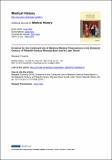Files in this item
Evidence for the continued use of medieval medical prescriptions in the sixteenth century : a fifteenth-century remedy book and its later owner
Item metadata
| dc.contributor.author | Connolly, Margaret | |
| dc.date.accessioned | 2016-03-18T14:30:15Z | |
| dc.date.available | 2016-03-18T14:30:15Z | |
| dc.date.issued | 2016-04 | |
| dc.identifier | 232768777 | |
| dc.identifier | ce024ec3-e154-40db-9f7e-a512d9890a3b | |
| dc.identifier | 84960951098 | |
| dc.identifier | 000373017400001 | |
| dc.identifier.citation | Connolly , M 2016 , ' Evidence for the continued use of medieval medical prescriptions in the sixteenth century : a fifteenth-century remedy book and its later owner ' , Medical History , vol. 60 , no. 2 , pp. 133-154 . https://doi.org/10.1017/mdh.2016.1 | en |
| dc.identifier.issn | 0025-7273 | |
| dc.identifier.other | ORCID: /0000-0001-5010-9782/work/40449122 | |
| dc.identifier.uri | https://hdl.handle.net/10023/8437 | |
| dc.description | This work was supported by the Wellcome Trust (grant no. 104798/Z/14/Z). | en |
| dc.description.abstract | This article examines a fifteenth-century remedy book, Oxford, Bodleian Library, Rawlinson c. 299, and describes its collection of 314 medieval medical prescriptions. The recipes are organised broadly from head to toe, and often several remedies are offered for the same complaint. Some individual recipes are transcribed with modern English translations. The few non-recipe texts are also noted. The difference between a remedy book and a leechbook is explained, and this manuscript is situated in relation to other known examples of late medieval medical anthologies. The particular feature that distinguishes Oxford, Bodleian Library, Rawlinson c. 299 from other similar volumes is the evidence that it continued to be used during the sixteenth century. This usage was of two kinds. Firstly, the London lawyer who owned it not only inscribed his name but annotated the original recipe collection in various ways, providing finding-aids that made it much more user-friendly. Secondly, he, and other members of his family, added another 43 recipes to the original collection (some examples of these are also transcribed). These two layers of readerly engagement with the manuscript are interrogated in detail in order to reveal what ailments may have troubled this family most, and to judge how much faith they placed in the old remedies contained in this old book. It is argued that the knowledge preserved in medieval books enjoyed a longevity that extended beyond the period of the manuscript book, and that manuscripts were read and valued long after the advent of printing. | |
| dc.format.extent | 22 | |
| dc.format.extent | 1232615 | |
| dc.language.iso | eng | |
| dc.relation.ispartof | Medical History | en |
| dc.subject | Remedy book | en |
| dc.subject | Medieval recipes | en |
| dc.subject | Bodley Rawlinson c. 299 | en |
| dc.subject | Thomas Roberts | en |
| dc.subject | Plague | en |
| dc.subject | Phlegm | en |
| dc.subject | Charms | en |
| dc.subject | Manuscripts | en |
| dc.subject | D111 Medieval History | en |
| dc.subject | PE English | en |
| dc.subject | R Medicine | en |
| dc.subject | SDG 3 - Good Health and Well-being | en |
| dc.subject.lcc | D111 | en |
| dc.subject.lcc | PE | en |
| dc.subject.lcc | R | en |
| dc.title | Evidence for the continued use of medieval medical prescriptions in the sixteenth century : a fifteenth-century remedy book and its later owner | en |
| dc.type | Journal article | en |
| dc.contributor.sponsor | The Wellcome Trust | en |
| dc.contributor.institution | University of St Andrews. School of English | en |
| dc.contributor.institution | University of St Andrews. St Andrews Institute of Medieval Studies | en |
| dc.identifier.doi | 10.1017/mdh.2016.1 | |
| dc.description.status | Peer reviewed | en |
| dc.identifier.url | http://journals.cambridge.org/repo_A10Lxs1n/GtJKg | en |
| dc.identifier.url | http://europepmc.org/articles/PMC4847415 | en |
| dc.identifier.grantnumber | 104798/Z/14/Z | en |
This item appears in the following Collection(s)
Items in the St Andrews Research Repository are protected by copyright, with all rights reserved, unless otherwise indicated.

